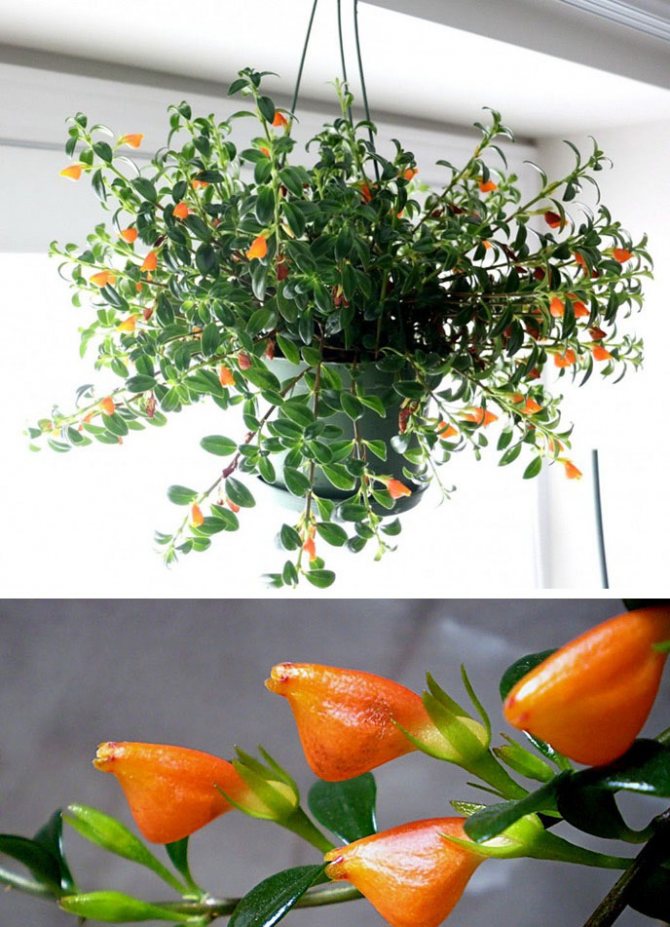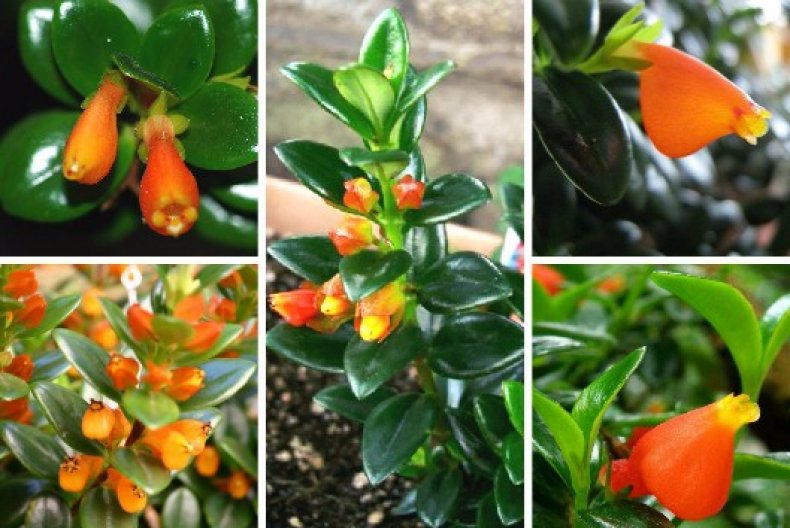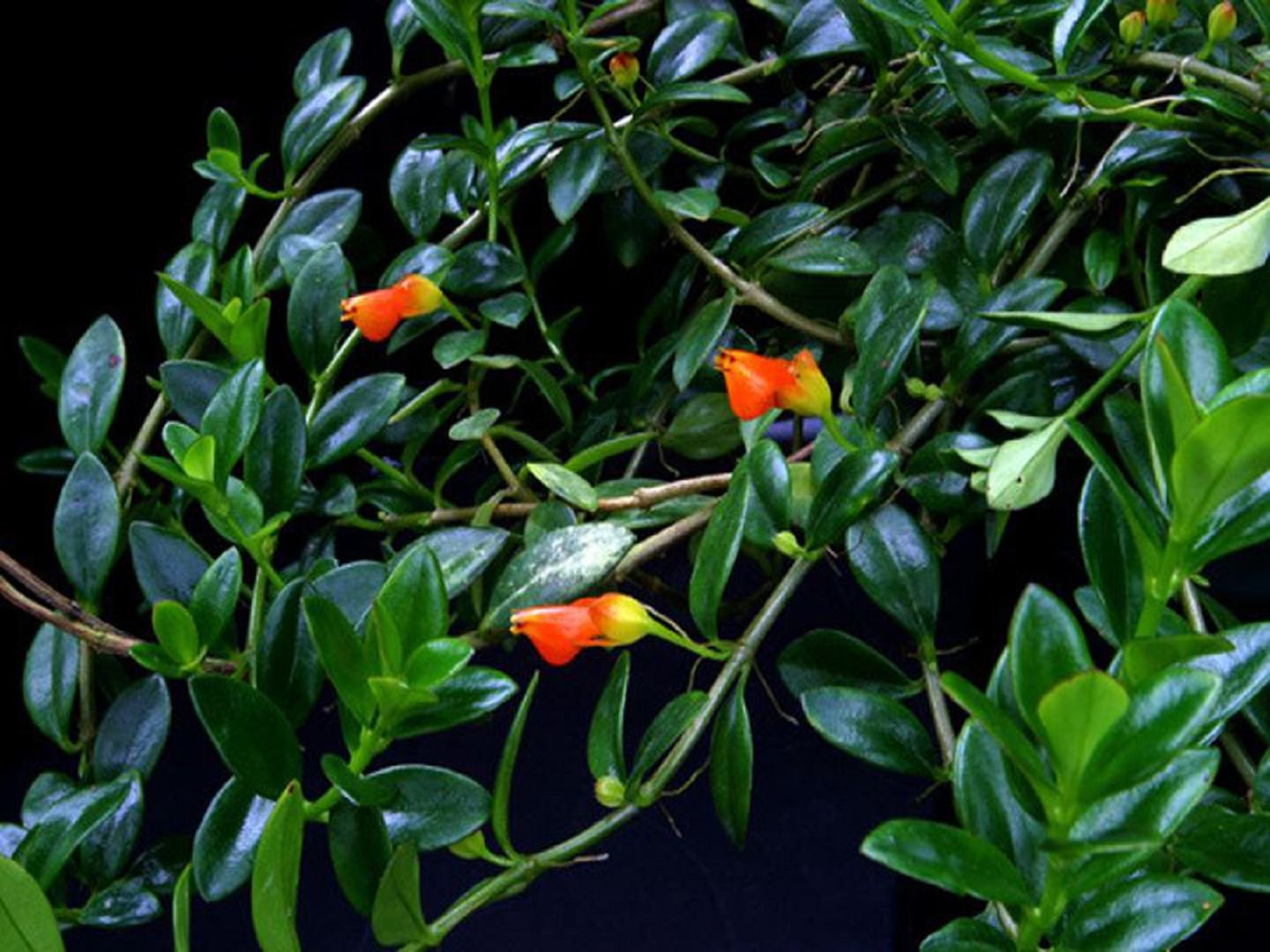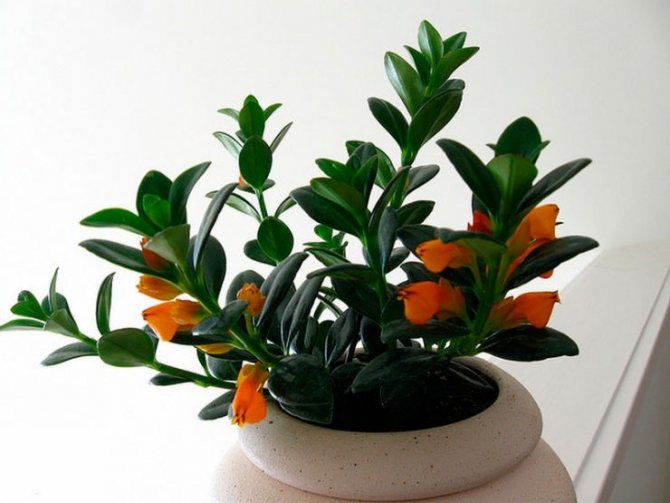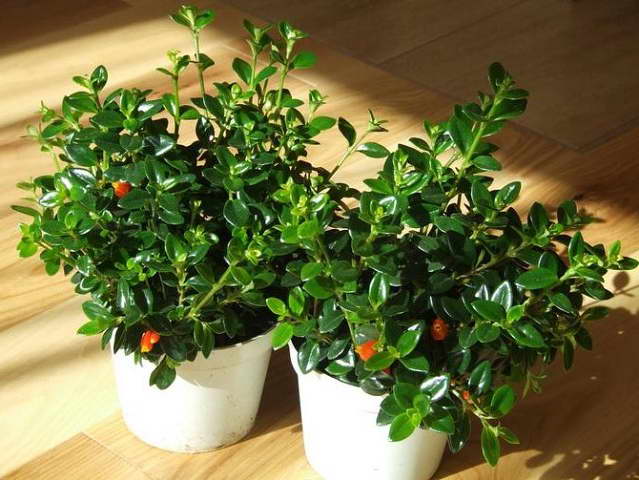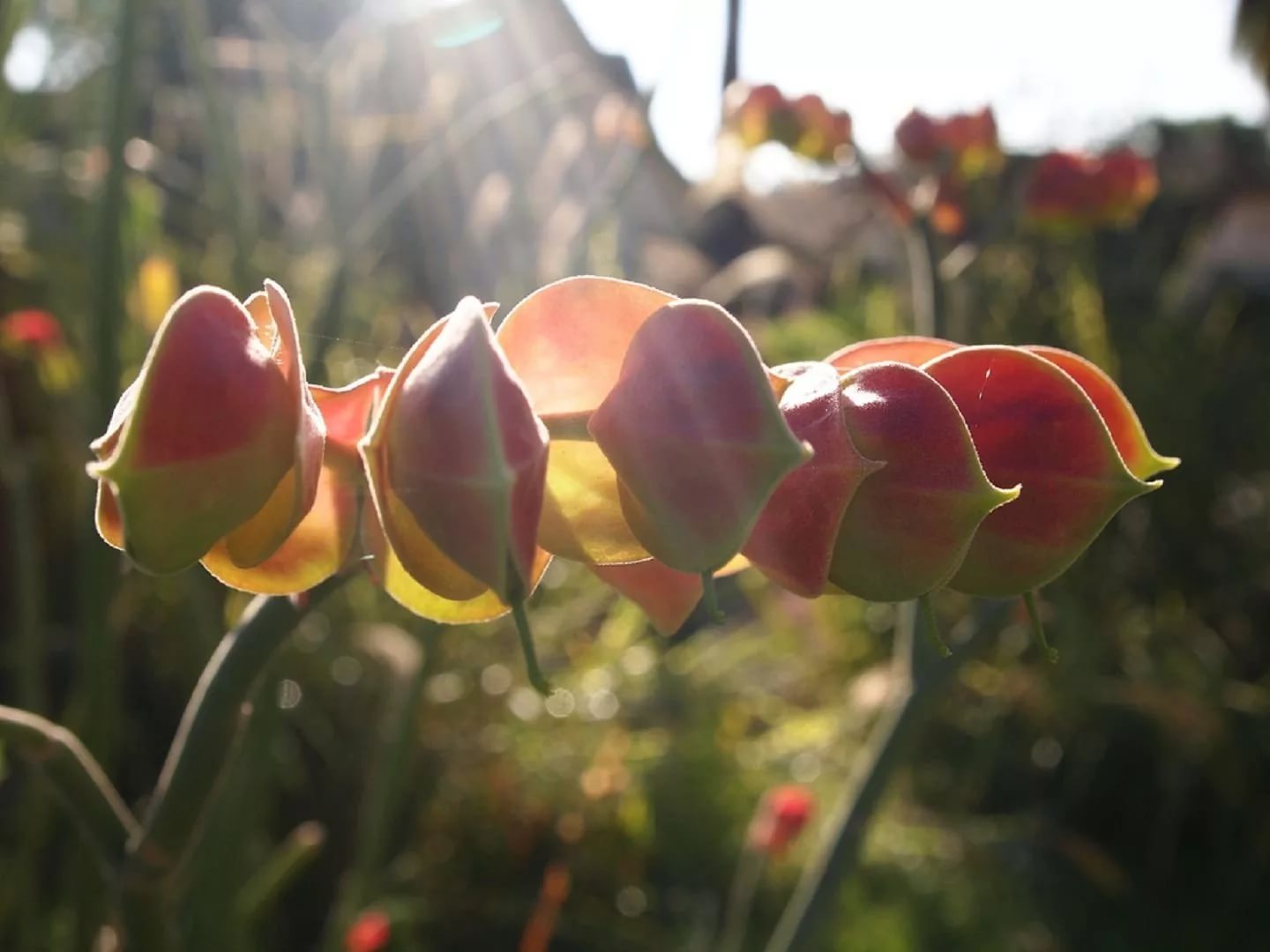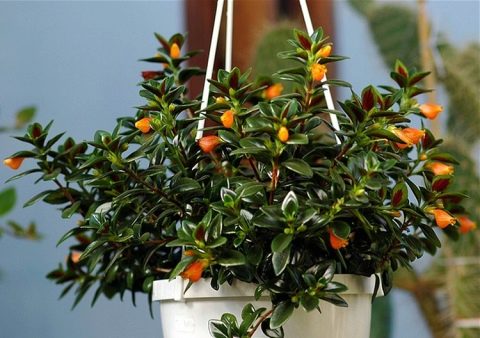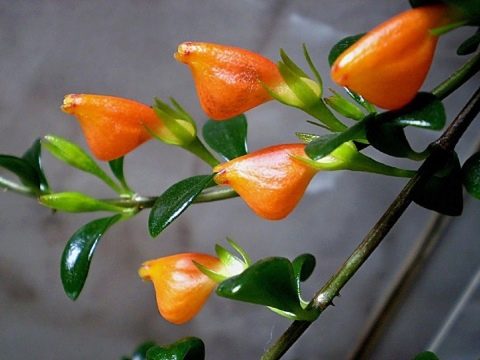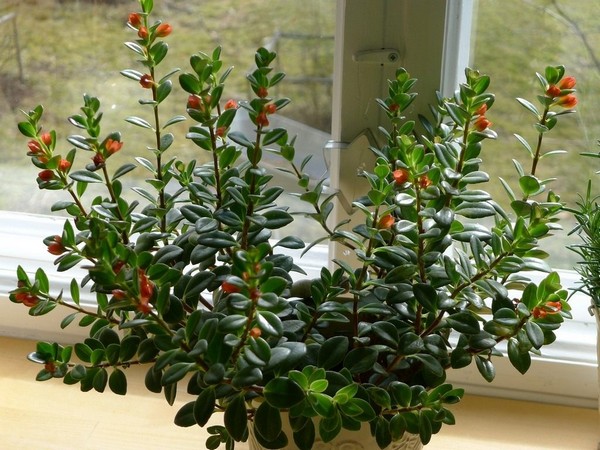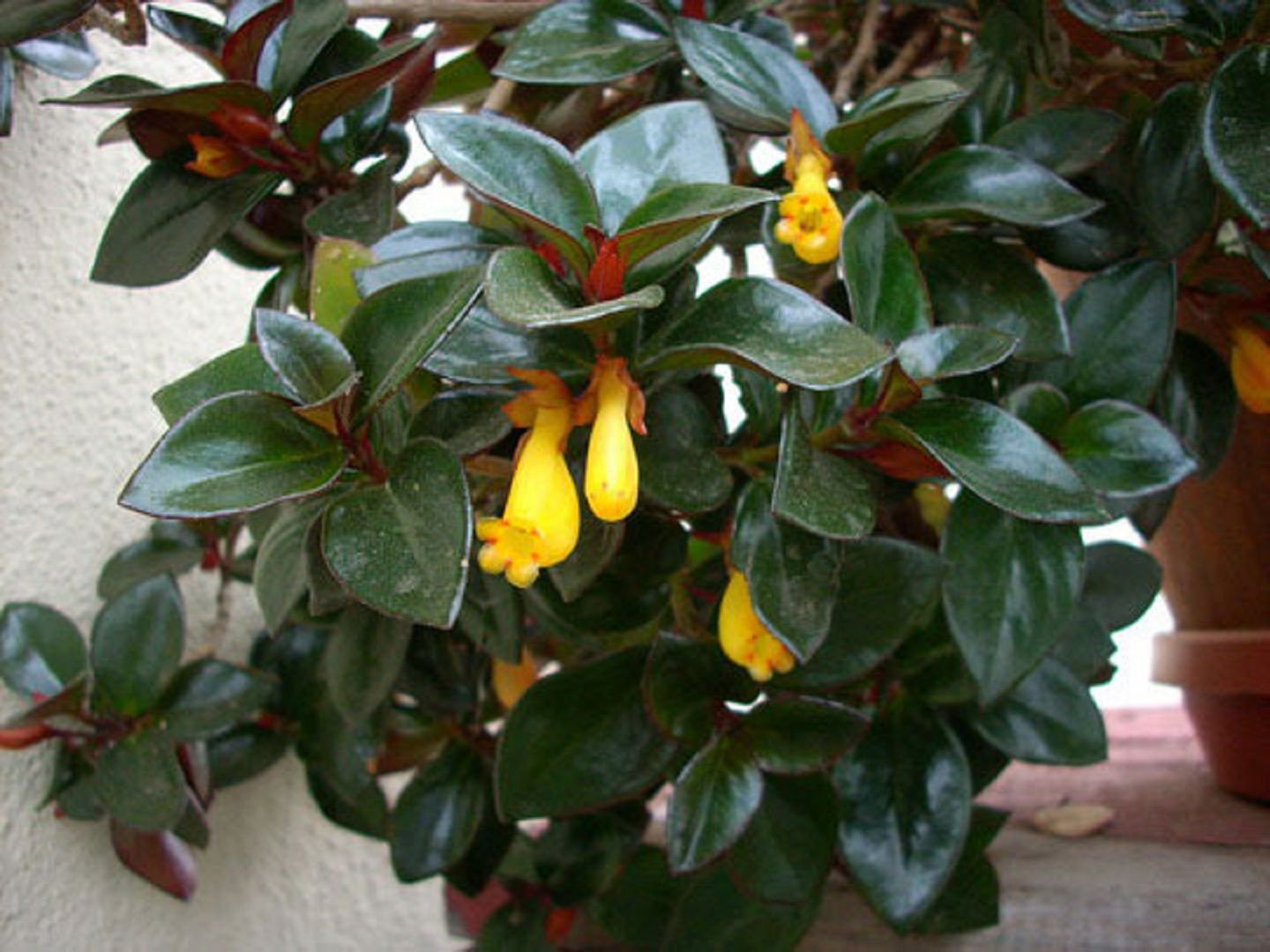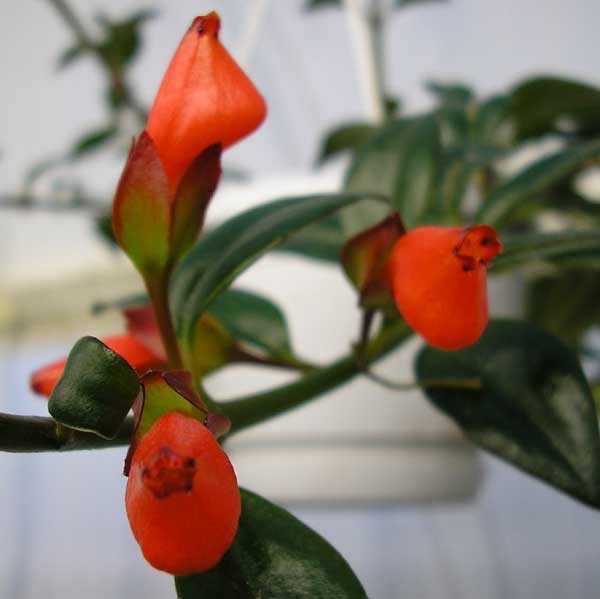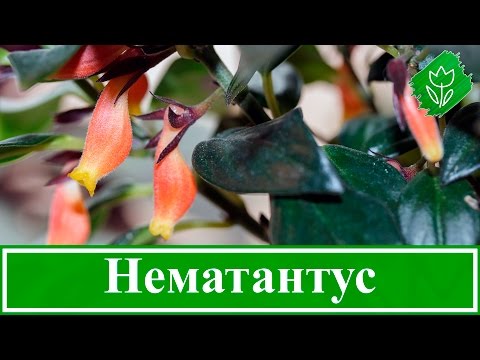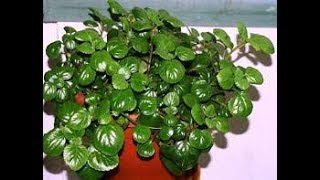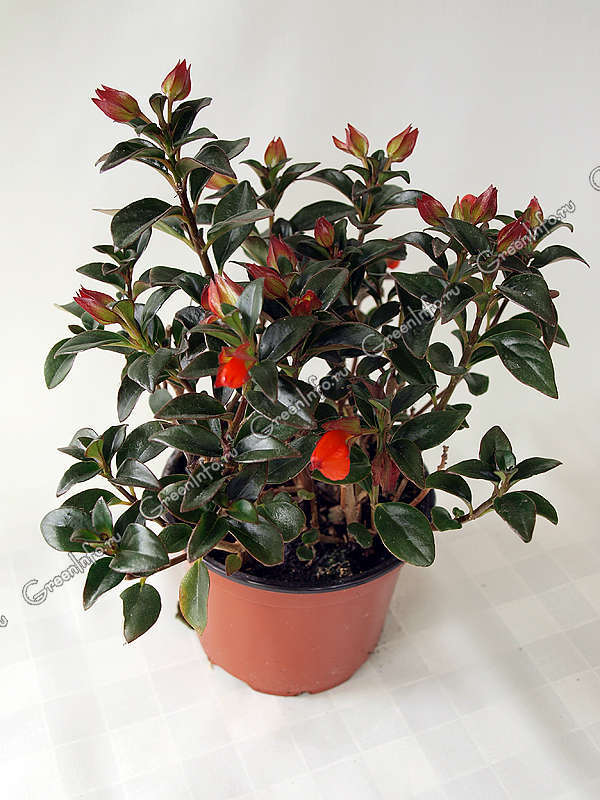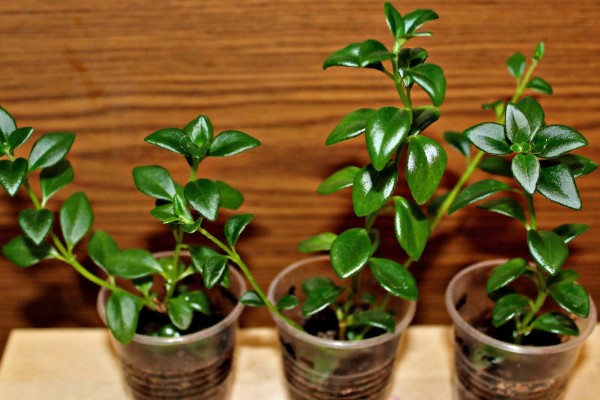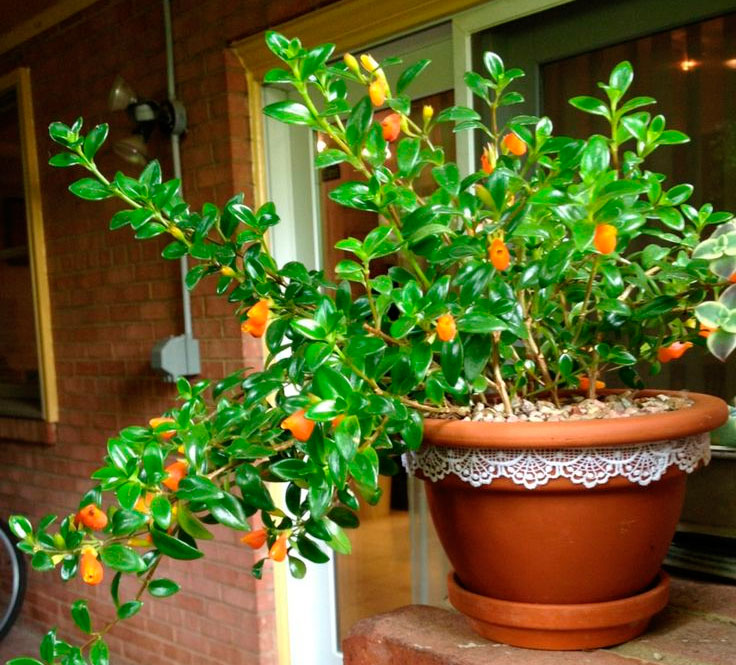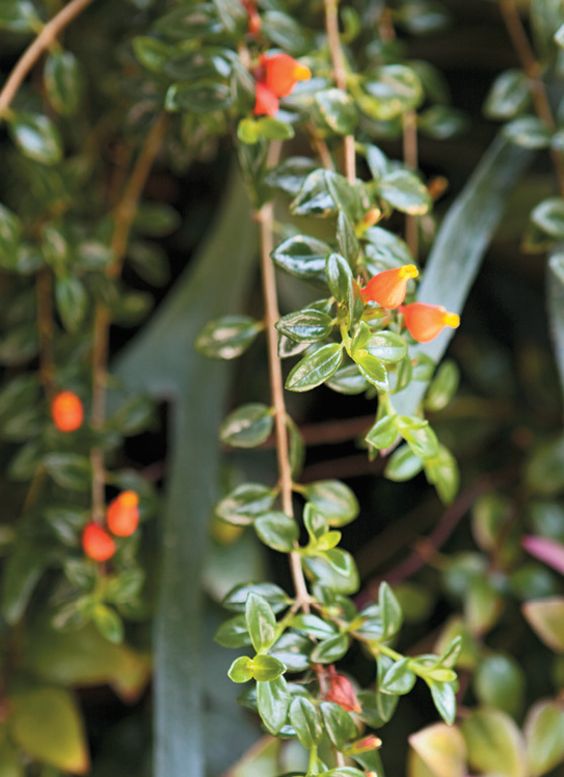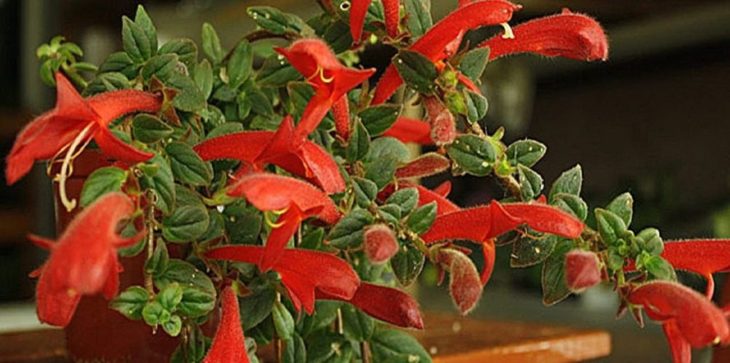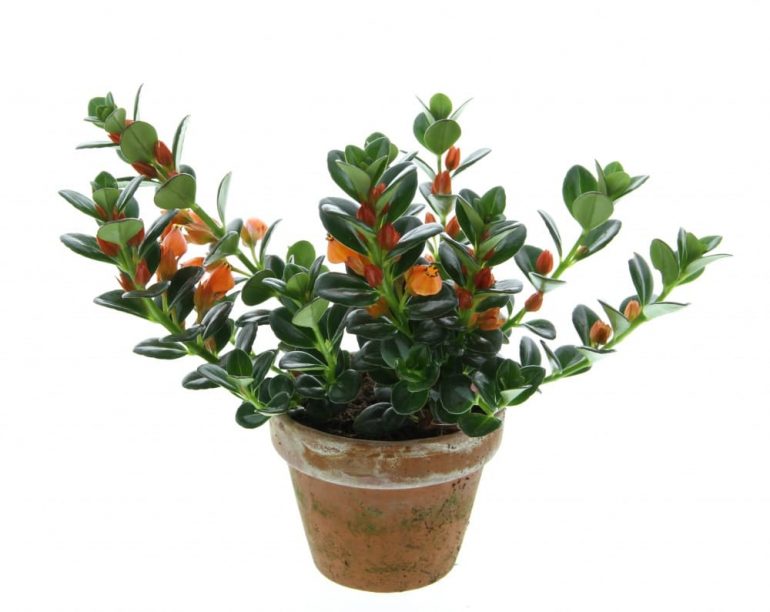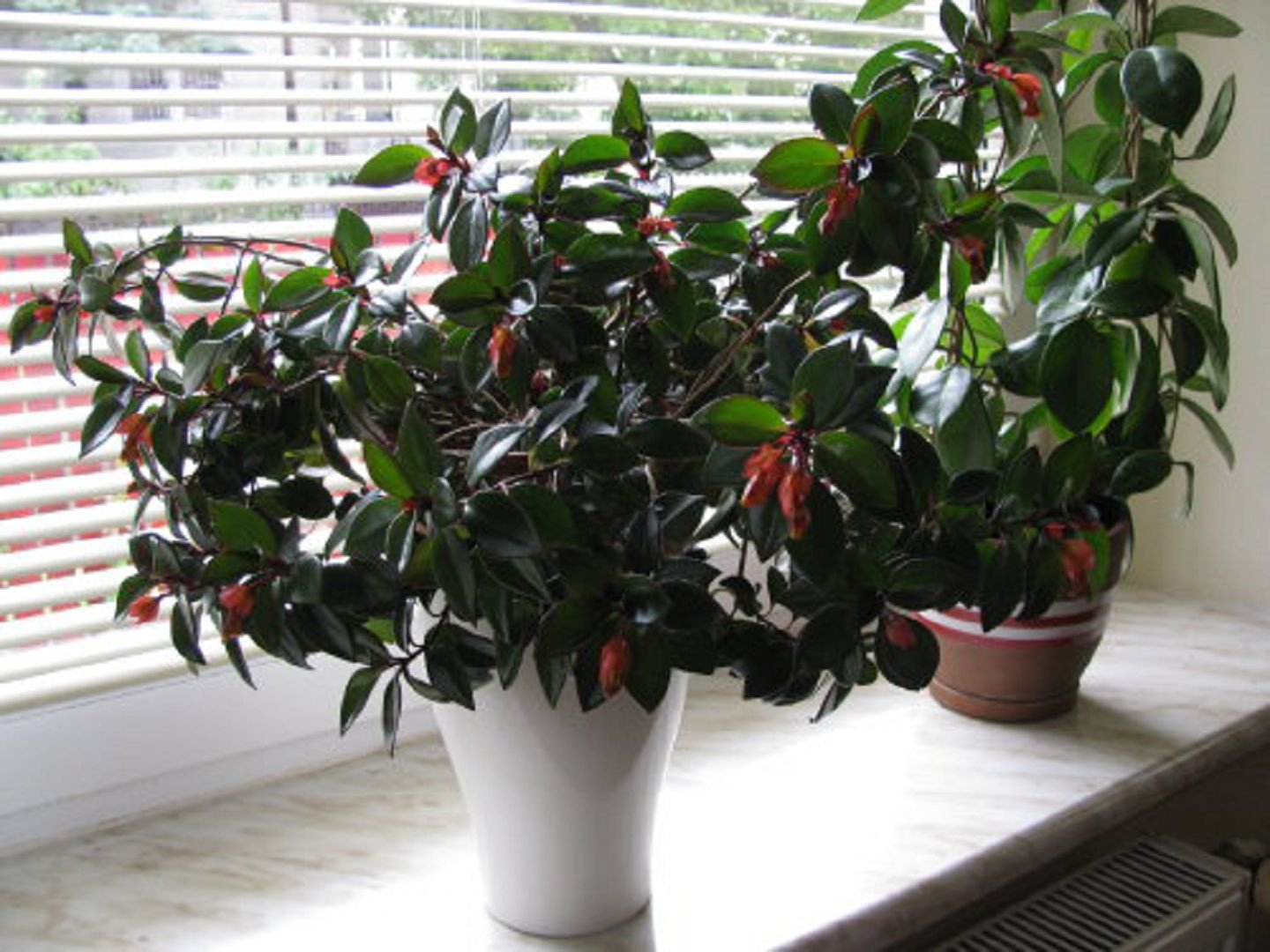Hypocyrt flower care
Let's take a closer look at how to care for the hypocyrt, including how to care for the hypocyrthus.
Location
Indoor hypocyrt loves a lot of light, but the direct rays of the sun negatively affect the culture. On warm and hot days, direct sunlight burns the sensitive leaves of the plant. This should not be allowed. In winter, it also requires good lighting. But in this case, you can get by with the installation of artificial light.
Temperature
The air temperature should be different every season. The most important thing is to avoid drafts and sudden temperature changes. In the summer from twenty to twenty-five degrees. In winter, from fourteen to sixteen degrees. Hypocyrta naked requires a temperature two degrees lower in winter than for other species.
Humidity
During the period of active growth of the culture, an increased indicator of air humidity is required. You can use the spraying procedure, or put a container with wet expanded clay next to the pot.

Watering
Abundant watering is needed only on hot days. In a moderate amount of liquid, watering is carried out in the fall. In winter, there is practically no need to water the crop. It is not worth bringing the soil of the flower to complete drying. You cannot use cold water.
The soil
The land should consist of one portion of peat, one portion of humus, one portion of sand and one portion of leafy soil. In shops you can buy land for violets. It is suitable for growing hypocyrt at home.
Fertilizers
Top dressing is applied during the period of active growth and development of culture. It is best to carry out the process every two months in the summer and spring. In flower shops, you can purchase liquid fertilizer for flowering varieties. In winter, the culture goes into a state of dormancy.
Transfer
Indoor hypocyrt flower is slowly growing. Therefore, there is no point in replanting it constantly. It is enough to do this once every two years. The pot must be matched to the size of the root system. Drainage holes and a void for the drainage layer must be present in the container. Otherwise, rhizome decay will occur.
Pruning
Before winter dormancy, the shoots of the culture are pruned. One third is removed from each of them. After this procedure, the stems will branch out better. In the future, there will be more inflorescences on the plant.

Reproduction of hypocyrtes
The best way to propagate hypocyrt is by cuttings. Cuttings are used from an adult. A young shoot is separated, which has five internodes. The breeding period is active growth (spring).
How to root a hypocyrt: in water or sand. Planting depth in the sand - up to the first leaves. Hypocyrt cuttings should be taken care of as usual, as well as all other cuttings of other plants.
It is necessary to create greenhouse conditions, regularly ventilate, keep the temperature in the room from twenty-two to twenty-four degrees.
As soon as long roots appear, the cutting is transplanted into a pot with a substrate. Several cuttings can be planted in one container. This will make the plant more lush and beautiful.
Frequent problems
- Brown spots on the blades are a sign of using too cool water for watering or a long time between waterings.
- Why does not hypocyrt bloom? This is influenced by a lack of light, an unsuitable substrate, few nutrients in the ground, a rough change in temperature, few (or no) shoots.
- The leaves turned yellow and twisted - this is a sign of direct sunlight hitting the plates.
- Leaves and inflorescences fall out - this is a sign of an excess of moisture in the soil, stagnation of liquid in the rhizome, too cold temperature in the room.
Reproduction and transplantation of a houseplant Goldfish
Nematanthus can be propagated by seed and cuttings. The seed method is quite laborious, with a low percentage of germination and poor subsequent growth. First, it is necessary to grow seedlings from seeds in a greenhouse. After that, you can plant the flower in a container with a substrate.
The most optimal option breeding - growing from cuttings an adult flower. In spring it is necessary to cut a branch with 4-5 nodes. All the lower leaves of the shoot are removed. The stalk is immersed in water or wet sand or peat. After that, the young plant is covered with a glass cover, under which the temperature is maintained at + 22-24 degrees. It is necessary to ventilate the seedling daily.

After the roots grow back by 3-4 cm, you can plant in a pot.
The plant must be replanted annually. This is best done in the spring before flowering. The new pot shouldn't be too big. The root system does better in a small space. At the bottom of the container, it is necessary to pour a layer of sand, pebbles or expanded clay to drain the water. The soil should be chosen with a neutral or slightly acidic environment, it should be loose and light.
You can prepare the substrate yourself by mixing humus, leafy soil, peat and a small amount of sand. You can add pine bark, moss, sphagnum and charcoal. It is better to purchase ready-made soil for Saintpaulias. This version of the substrate is cleared of diseases and pests, and the transplantation will not lead to the development of flower diseases.
To get the roots from the old substrate should be extremely careful, trying not to injure them. It is not necessary to completely remove the old soil
After planting in a fresh substrate, the flower is watered and fertilized.
Hypocyrta - care:
Lighting:
Hypocyrta is such an unpretentious plant that can grow both in direct sunlight and in the shade. In the shade, Hypocyrt will quickly lose its decorative effect and stop blooming. The ideal place for Hypocyrta is partial shade. In the summer, the plant can be taken outside for ventilation. In winter, you can create additional artificial lighting.
Temperature:
In the summer, a flower is provided with a temperature of eighteen to twenty degrees. In winter, the plant is provided with a cool temperature of twelve to fifteen degrees. With a cool winter, the plant will provide abundant flowering. Extremely low temperatures can cause the plant to shed its foliage.
Watering:
For irrigation Hypocyrta use soft water. Watering in both summer and winter should be done in moderation. From an excess of moisture in the plant, leaves may fall off. From watering with cold water, brown spots may appear on the leaves of the plant.
Humidity:
In the summer, you will have to specially humidify the air for the plant, because dry air can harm the foliage. To do this, spraying is periodically performed or a pot of flowers is placed in a pan with wet peat.
Top dressing:
It is necessary to feed Hypocyrta throughout the season from April to August, at intervals of one week. In winter, the plant does not need additional feeding.
Transfer:
For Hypocyrta, it is imperative to provide good drainage. The soil mixture for the Hypocyrta transplant should contain peat, sand and leafy soil. The soil should be as light as possible. Hypocyrta is transplanted at intervals of one year. The pot should be small.
Reproduction:
Hypocyrta can be propagated in summer and spring, using the method of cuttings. For cuttings, a more mature plant is selected, the top of the stem without flowers is cut off from it in the presence of four to five nodes.The lower leaves from the cuttings are removed, and the cuttings themselves are placed in wet peat or sand. After that, it is necessary to cover the cuttings with jars or foil, providing them with greenhouse conditions. The pots must be placed in a bright room at room temperature. After the cuttings are rooted and strengthened, they can be transplanted into separate pots, as an independent plant.
Some features:
Hypocyrta has one ability - only young shoots bloom in it. Young shoots can only form after pruning old branches. The better pruning is done, the more abundant the flowering will be. Pruning of branches is done after the plant has bloomed.
Why the nematanthus does not bloom and other problems during cultivation
"Why the nematanthus does not bloom" - often the growers who grow this crop ask this question. Usually, in good conditions, the buds appear very quickly. Flowering occurs in March, can last until September-November. In the presence of bright lighting, if phytolamps are used, it can bloom in winter. But there is one nuance in this: the plant loses its strength.
It so happens that the bush does not begin to bloom at all. This often happens when the flower does not grow in the right conditions for it.
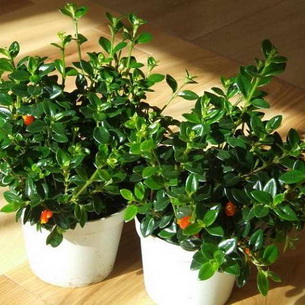
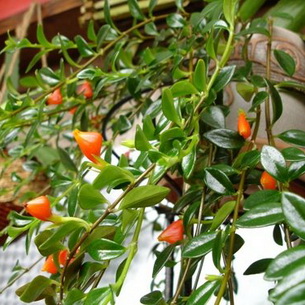
So, there may be several reasons why this culture does not bloom. First, as mentioned above, a large pot was chosen for it. Secondly, flowering will not occur if the plant does not have enough light. Thirdly, the reason may be the depletion of the bush due to a lack of fertilizers, or poor watering. Another reason for the low number of flowers is the lack of a dormant period in the nematanthus. If you do not prune the bush, it is unlikely that buds will begin to form on it.
It so happens that the leaves of a plant wither, but at the same time they do not dry out, but gradually turn yellow and fall off. This indicates decay of the root system. The reason for this is often a fungus found in permanently moist soil. At the first signs of this disease, you should remove the plant from the pot, examine its roots, eliminate the affected and transplant it into a fresh substrate, having previously disinfected the container for it.
If young shoots and buds began to curl, and then dry up, you need to inspect the bush. Most likely it was attacked by aphids. If it is found, the hypocyrt should be treated with a special preparation against this insect.
If yellow spots began to appear on the surface of the leaf plates, and a cobweb is visible, it means that a spider mite has settled on the bush. In the fight against insects, insecticide "Kleschevit" and similar preparations will help.
Breeding a houseplant hypocyrtus (nematanthus)
Not all growers decide to breed this exotic flower, fearing that they will not be able to create suitable conditions for it. This culture needs warmth, moderate air humidity, periodic pruning to give a beautiful shape to the bush.
It is important to arrange a dormant period for the plant so that it can form abundantly buds and bloom for a long time. There are also very unpretentious varieties that require a minimum of care.
Below are tips for caring for a hypocyrte flower (nematanthus) at home, supplemented with photos that allow you to understand how to do this work correctly without making gross mistakes:
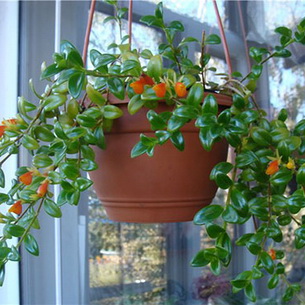

Lighting. This plant is photophilous, but it does not always need bright lighting. So, for example, in spring it should grow with an abundance of sunlight, or in partial shade. Lack of light will negatively affect bud formation. The optimal place for him in the spring will be windows facing south-west, west, southeast and east. When grown on a south-facing window, the bush will need to be shaded from direct sunlight.
In summer, it is better to place a pot with a plant on the street, on a balcony or loggia, but in a place where the bush will stay for a long time in bright light.
In the autumn period, the indoor nematanthus flower should also be in a room with diffused light, but it can also be grown in partial shade.

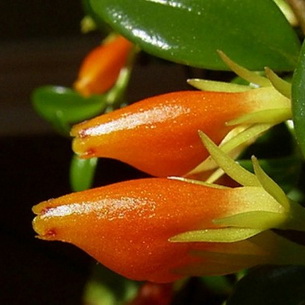
In winter, the shrub needs bright light, shoots will begin to stretch out from its lack, the leaves will become small, decorativeness will be lost. With a decrease in daylight hours, it will be necessary to use supplementary lighting during this season. Nematanthus should be illuminated in winter for 12 hours a day.
Watering. During active growth, development and budding, the flower should be watered abundantly, preventing the soil from drying out. With a lack of moisture, the leaves of this culture curl and fall off. In winter, watering is reduced. If the flower hibernates in a cool room with a temperature of 12-15 degrees, watering is enough once a month. With the onset of spring, watering is increased, but this is done gradually.
Air humidity. Air humidity requirements depend on the type and variety of nematanthus. Many varieties thrive in dry air, while others get sick. In any case, with prolonged heat, the plant must be sprayed, but try not to get on the buds. In winter, spraying is carried out much less frequently than at any other time of the year.
Temperature. The optimum air temperature for this culture is 20 - 26 degrees. Higher rates are acceptable in summer. In winter, the bush should be kept at a temperature of 15 - 18 degrees. Even at a temperature of 13-14 degrees, the nematanthus hibernates, but irrigation and spraying is not done at all.
The soil. The soil for nematanthus should be made of leafy earth, sand and peat, which are taken in equal proportions, then crushed moss is added to the specified components. A soil mixture consisting of leafy earth (2 parts), humus, peat, sand (1 part each), a small amount of crushed charcoal is suitable for culture.
A drainage layer is laid at the bottom of the container, which will prevent stagnation of water in the soil, and hence the decay of the root system.
Fertilizer. Top dressing is applied only during the period of leaf formation and flowering. This procedure is performed 2 times a month. During the rest period, feeding is not needed.
Mineral complexes for flowering indoor plants are used as fertilizer. They should include potassium and phosphorus. Top dressing is applied immediately after moistening the soil.
Pruning. In order for the nematanthus to be a lush, abundantly flowering bush, it should be periodically pruned. This work is done once a year in the autumn period after flowering. Thin, weak, damaged shoots are cut first. Healthy young stems are shortened by 1/3. 1/2 old stems. If you do not carry out this procedure, the plant will lose its decorative effect, it will form much fewer buds.
Growing freesia outdoors
Before planting bulbs in open soil, it is recommended to grow them. To do this, in March or April, the scales must be removed from the corms, and then they are placed for 30 minutes in a foundationol solution (0.2%), which will help prevent the development of fungal diseases. After that, they are planted in nutritious loose soil in peat pots, deepening by 50 mm. Then they are transferred to a warm loggia or to a windowsill with good lighting, where the bulbs will stay in the soil before planting. Experienced gardeners sometimes resort to seed propagation of such a plant, but it should be borne in mind that this method is rather laborious and ineffective.
The substrate should be moistened and then the seeds are carefully placed on its surface. Sprinkle on top of them with a layer of soil mixture for seeds, the thickness of which should be about 20 mm
Then the container must be covered with glass or foil and removed to a well-lit place. After 3 weeks, the first seedlings should appear. After their height reaches 20-30 mm, the shelter must be removed and the seedlings thinned out. Planting in open soil is carried out in mid-May.
preparation of freesia bulbs for planting / freesia. Preparation for planting bulbs
Landing in open ground
It is necessary to plant such a plant in open soil in spring, when the threat of frost has passed (after about May 9). The size of the holes should be such that the planting depth is 30–60 mm. A distance of at least 30 mm should be maintained between small bulbs, and about 50 mm between large ones. Row spacing is approximately 15 centimeters. After planting freesia, the surface of the site is leveled and covered with a layer of mulch (peat or coniferous soil), which will prevent overheating of the soil and the root system of the bushes. In August, each bush will have 1-3 peduncles, while flowering will last until the first days of October.
we plant freesia in open ground
Care features
During the growing season, freesia needs timely feeding. For the first time, the plants are fed according to the seedlings, for this, a solution of ammonium nitrate is used (2 g of the substance is taken for 1 liter of water). After that, once every 2 weeks, the plants are fed with superphosphate and potassium salt (for 1 liter of water 4 g and 2 g, respectively)
Also, when growing in a garden, you should regularly loosen the surface of the site and remove weeds, special attention should be paid to these procedures in the first half of the growing season. When growing freesia in the open field, it needs a certain watering regime.
During the period of active growth, and when it will bloom, it is necessary for watering to be abundant and systematic, while the soil should be moist all the time. Flowering lasts 3–6 weeks, after which the flowers begin to water less and less each time until they stop. In addition to watering, such plants need systematic spraying of leaf plates and shoots. Watering and spraying is recommended in the evening, but it should be borne in mind that the water must have time to be absorbed before nightfall. In the garden, freesia is grown before the frost begins.
Diseases and pests
The pests and diseases in this plant are the same as in gladioli, namely: aphids, thrips, spider mites, and also fusarium, scab and various rot. Infected bushes should be dug up and burned. And in order to protect them from disease, it is necessary to disinfect the bulbs in a weak solution of potassium manganese before storing them. The same procedure should be followed before planting them. Also, proper watering will protect freesia from diseases, remember that during its growth and flowering, the earth should not be dry, but at the same time, stagnation of water should not be allowed.
Characteristics of nematanthus or hypocyrtus
Hypocyrta grows in the forests of South America, mainly along large rivers and near bodies of water. In its natural environment, it occurs in the form of herbaceous plants, shrubs, dwarf shrubs, epiphytes. The flower is a representative of the Gesneriaceae family. The modern scientific name is nematanthus, since at present the genus Hypocyrtes no longer exists and it is customary to refer them to Nematanthus.
Cuticle-covered leaves are fleshy, dense, waxy. Most often they are dark green, sometimes the back of the leaf is purple or red. Depending on the type and variety of the flower, the length of the leaf can be from 3 to 10 cm. More often they are ovoid, but there are specimens with an elliptical leaf shape. In some varieties, the leaf plate is omitted. If the branch is rooted, new roots can begin to grow from the leaf axils. In humidified air, aerial roots grow from them.
The popular name of the flower - Goldfish - arose due to the fact that unusual flowers, reminiscent of an aquarium fish, gather in characteristic axillary inflorescences.

As you can see in the photo, a swollen yellow or orange corolla is surrounded by fused petals diverging at the top.
Waxy buds up to 5 cm in length, can be colored red, orange, yellow, pink or dark purple. In some varieties, they hang from a long thin pedicel. With proper care on the hypocyrt from early spring to late autumn, the buds bloom alternately. Flowering is usually abundant.
It will also be interesting: Azalea - home care, reproduction and transplantation after purchase?
Description
- Leaves can be of two shapes: ovoid and ellipse. Their tips are slightly pointed. Some species have smooth plates, and some are pubescent. On the back there is a lilac leaf.
- Flowers grow near the base of the leaves. They appear in the form of a tube, which are slightly enlarged towards the bottom.
- Some species grow upright and erect. Their height reaches sixty centimeters. Some in the form of vines have creeping shoots. Their length can be up to fifteen centimeters.
- Hypocyrta is popular with flower growers due to its unusual type of foliage and inflorescences.
Views
The most popular types of culture are:
Coin hypocyrt
The stems are straight. They are not branched. The leaves are thick and strong. They can be compared to the foliage of a money tree. The only difference will be a small fluff on the plates, stalks and shoots of the coin type.
The shape of the leaves is slightly rounded. The shade is light green. The inflorescence includes: orange buds and a yellow corolla with a red tint. When the flowers have withered and fell, the leaves follow to the ground in the wake of them. From this moment on, the state of rest in culture begins.

Hypocyrta nude
The distinctive characteristics of the two types is the color of the leaves. In naked, they are bright green in color with a glossy overflow. The color does not change throughout life. Shoots grow straight and do not have large branches.
The maximum plant height is twenty-five centimeters. The leaves grow on small petioles. The length of the plate can be no more than three centimeters. Peduncles are also small in size. Inflorescences grow on them, outwardly resembling bloated flowers.
You can buy naked hypocyrt at any specialized flower shop or nursery.
6 Potential Care Difficulties
Even an experienced grower can face certain difficulties when growing hypocyrtes. This can be easily avoided if you keep the flower under favorable conditions and follow all the care recommendations. The most common mistakes of indoor plant lovers are presented in the table:
| Symptoms | Causes | Treatment |
| Hypocyrta does not bloom | Volumetric pot. Lack of light. Lack of nutrients. Lack of a dormant period | Transfer the hypocyrtu into a smaller pot. Move the pot to a brighter place or add additional lighting. Feed once every 2 weeks with a complex composition for flowering crops. For the winter, move the pot to a cooler place and limit watering |
| Scale insect, whitefly, spider mite, thrips, mealybug, aphid | Errors in care, decreased plant immunity | Treat the flower with a suitable insecticide effective against the identified pest (Antitlin, Aktellik, Akarin, Kleschevit, Fitoverm). 2 weeks after the first treatment, re-spray with the drug |
| Powdery mildew, gray rot | High humidity when kept cold | Remove the affected parts of the plant, treat the flower with a fungicide. In case of severe root damage, cut off cuttings from healthy shoots and root. In the future, strictly follow the care recommendations |
| Leaves and buds fall | Constantly damp ground when kept cold. Overdrying an earthen coma in the warm season | Transplant into new soil, then water sparingly, avoiding waterlogging. On hot days, monitor the state of the soil in the pot, water when the topsoil dries out by 1-2 cm |
| Leaves turn pale, turn yellow and curl | Result of exposure to direct sunlight | Shade the flower with translucent tracing paper or tulle curtain |
| The edges of the leaves dry and turn yellow | Dry air in the apartment | Increase the air humidity in any way possible: using a humidifier device or frequent spraying of moisture from a spray bottle |
| Brown spots on leaves or buds | Water droplets during spraying | When humidifying the air, do not direct the spray jet at the plant. |
| The plant withers for no apparent reason. | Excess minerals in the soil | Feed no more than 1 time in 2 weeks, use a weak concentration of fertilizer |
If you follow the recommendations of experienced florists, there will be no problems in the hypocyrt care process.

Care

The southern beauty loves light and warmth, therefore, has claims to the living conditions in our climate. At home, you need to create the appropriate care and microclimate. The air temperature in the summer needs moderate (19-23 degrees). In winter, the plant is comfortable at a temperature of about 12-14 degrees, but not lower. You can't even supercool a pot with a bush for a short time, at 7 degrees the plant may die. In the summer, so that the plant does not overheat and does not suffer from heat, at temperatures above 27 degrees, it must be exposed to fresh air under diffused light or in partial shade. This can be a place in the garden or on the balcony, but without a draft.
Nude hypocyrta loves bright, 12-14 hours a day, but diffused lighting. It needs to be shaded a little from direct sunlight if it is located on the south side. It is best to place the pots with bushes on the windowsills of the east or west side of the house. In the cold season, when there is little natural light, you can additionally illuminate the plant with a lamp for several hours. With a lack of light, the stems may thin and stretch, and the flowering will become more scarce.
In warm and especially hot seasons, hypocyrt needs very humid air, so the air and foliage should be moistened with frequent spraying. Good drainage in the pot is important so that due to stagnant water in the soil, root rot does not develop and foliage does not begin to fall
Therefore, you need to water carefully, monitoring the condition of the soil. It is better to underfill a little than to water it heavily.
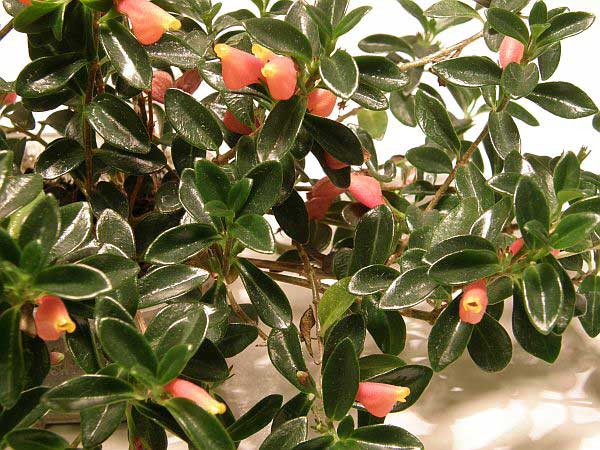
During the growing season and flowering, in spring and summer, watering should be regular and abundant. Use standing, soft and slightly lukewarm water. Bushes with large leaves need more water than small-leaved ones. In the autumn, watering is gradually reduced and it is checked that the next watering takes place only after the top layer of soil in the pot dries well. So they bring to rare watering during the wintering period. But, on the other hand, it should not be allowed that the earthy clod completely dries up. If you correctly provide the plant with a dormant period, then next year it will delight you with an abundance of flowering.
The plant is fed with a solution of mineral fertilizers, which is used for flowering indoor plants; they can be bought at a specialized store. The procedure is carried out weekly, only from April to October, during the growing and flowering season.
Caring for a naked hypocyr at home provides that, depending on weather conditions, the plant can be moved to a place where it will be more comfortable, taking into account its natural needs. For example, in the summer, send it to the fresh air in the garden or on the balcony, choosing a shaded place. The plant does not tolerate drafts, so you should take care of its correct location. In winter, it is best to keep in a cool but well-lit place and rarely water. To stimulate abundant flowering and bushiness well, you need to prune the stems, shortening them by 1/3 part. This procedure is best done in the fall before the dormant period or in early spring before the start of the growing season.



